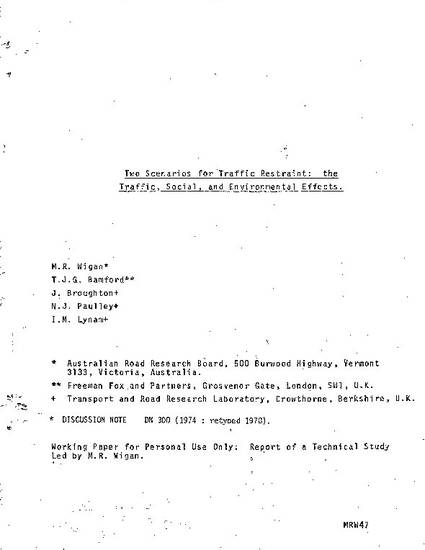
Unpublished Paper
74 DN300 Coventry Study on Traffic Restraint r.pdf
Discussion Notes by Marcus Wigan (DN300)
(1974)
Abstract
Original 1974 Abstract:
Different measures have been proposed to restraint the traffic in towns to give pleasant environmental conditions, and to allow traffic to move at a reasonable rate. These measures include parking controls, road pricing, supplementary licences, physical barriers, and cordons of toll points round congested areas. The theoretical techniques required to analyse these policy proposals in a transport planning context have now been developed together with environmental impact appraisal methods, and a full study of the effects and the limitations of these different forms of traffic restraint has been carried out on two scenarios based on those designed by the City of Coventry for their Transportation Study. The situation in 1967, when a low level of parking control was quite sufficient to meet the practical and economic objectives, has been studied to show how the different restraint policies might be best analysed in lightly congested conditions. The 1981 forecast situation under the low investment option considered in the Coventry Study was then modelled to determine the effects and the economic results of different restraint schemes under the difficult conditions expected for that year. Traffic benefits are not the only positive results of restraint, and a special environmental impact assessment model has been developed and applied to show how the noise,_ smoke, lead, carbon monoxide, nitrogen oxides, and airborne hydrocarbon concentrations would affect people under each restraint option. It is clear that although the design of restraint systems can reasonably be undertaken, and the traffic and high levels of environmental impacts forecast, the evaluation of environmental factors to similar standards cannot at present be achieved. The distributional impacts, which could have wider social consequences, are also presented to show how different restraint instruments can have divergent distributional results even when the overall benefits reach the same aggregate totals. The scenarios used were not specifically tailored to the actual condition, present or expected, in the City of Coventry, and would have required considerable variations to achieve this. Comparative runs with other such scenarios did not, however, substantially alter the nature of the relative results discussed.
Keywords
- road pricing social impact accessibility equilibrium assignment elastic demand freight noise air pollution parking policy
Disciplines
Publication Date
Spring 1974
Comments
This was the first known systematic policy analysis of road pricing, parking and physical restraint on a real city where social, environmental and pedestrian impacts were also analysed at the same time. The work was done 1969-4 by a team led by Marcus Wigan, with Neil Paulley and James Bamford the other two key members. Apart from the ground breaking accessibility and environmental impact modelling, the entire study was only possible by the development of theoretical methods that permitted reliable and consistent convergence of the underlying equilibrium model of travel movement to be systematically verified to have reached a high and consistent level of convergence. This was achieved by an elegant technique involving perturbing the system and allowing relaxation back to the start point once convergence had been apparently reached, using an optimising formulation of the assignment problem to verify the convergence stability and repeatability. The technique proved to be extremely robust and allowed reliable, repeatable and usable results from some very small prices and changes being evaluated, and to allow mixed parking and pricing strategies to be handled cleanly.
A historical note is that the modular adaptable model construction design and coding methods developed in the late 1960s allowed two complete large Coventry models to be run at the same same---in 128kb System 4/70 and every light on the control panel and every disc and tape was madly whirling when this was done-even the operator console control kernel was kicked out to enable this..Several tricks were used to create virtual discs on magnetic tapes, memory and discs to enable this, patching the File Control Blocks to do so.
Citation Information
Wigan, M. R., Paulley, N, Bamford, J. and Lynam,, I (1974). Two scenarios for traffic restraint: the traffic, social and environmental effects. Australian Road Research Board and Crowthorne, UK, Transport and Road Research Laboratory.(Unpublished)
